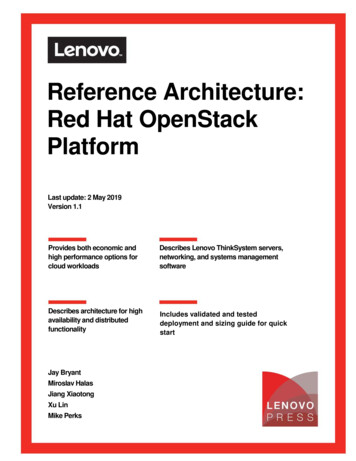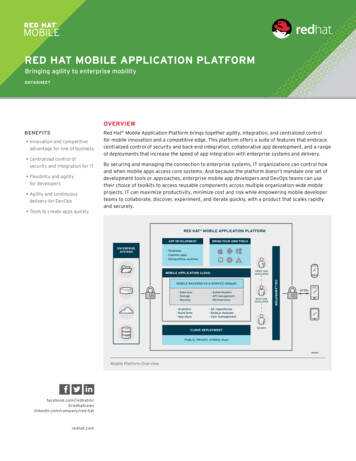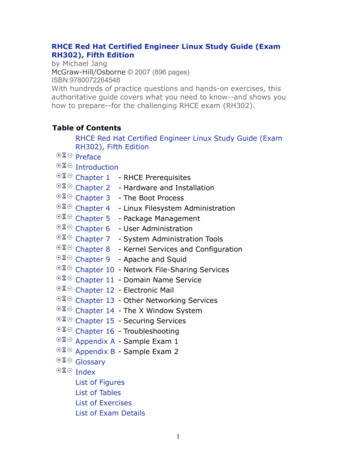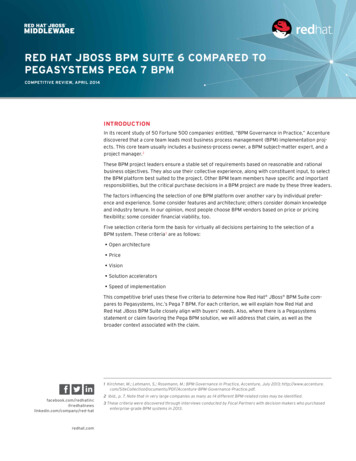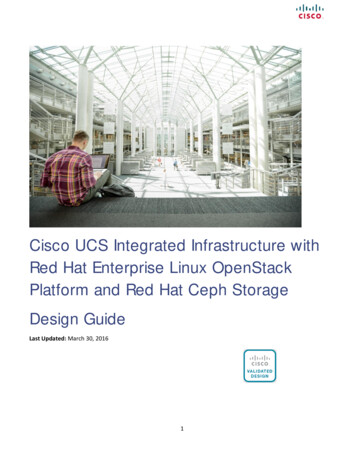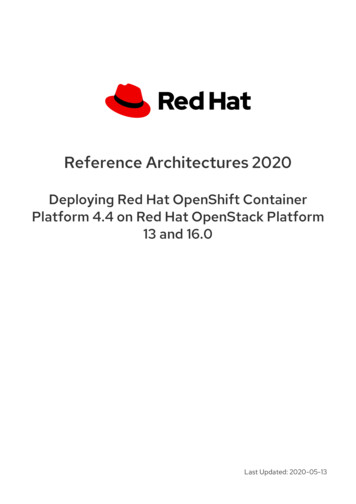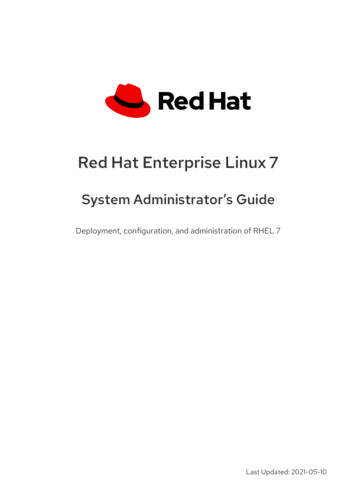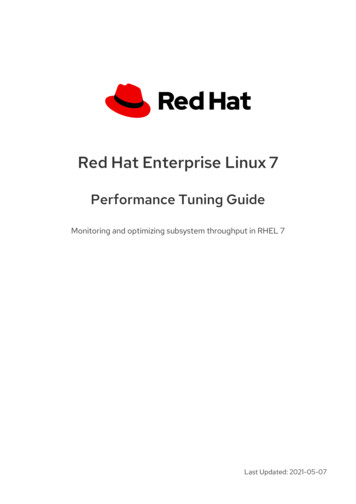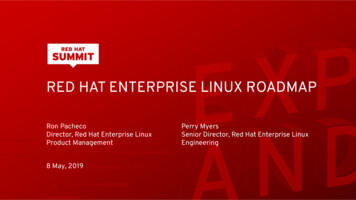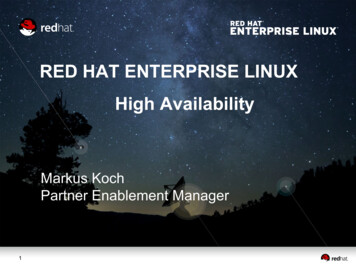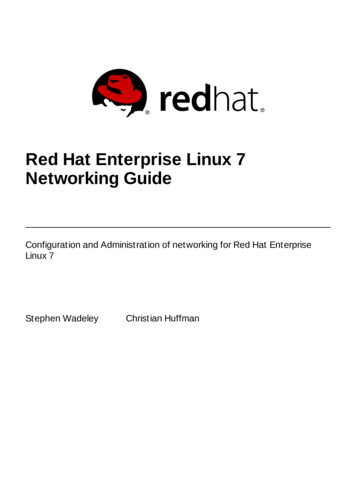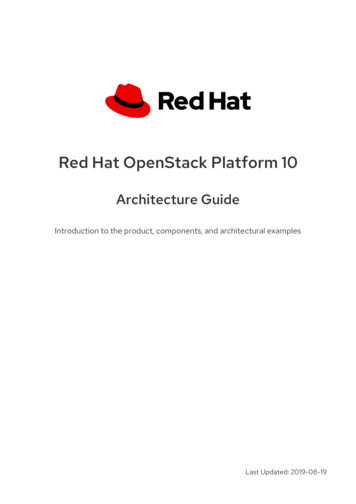
Transcription
Red Hat OpenStack Platform 10Architecture GuideIntroduction to the product, components, and architectural examplesLast Updated: 2019-08-19
Red Hat OpenStack Platform 10 Architecture GuideIntroduction to the product, components, and architectural examplesOpenStack Teamrhos-docs@redhat.com
Legal NoticeCopyright 2019 Red Hat, Inc.The text of and illustrations in this document are licensed by Red Hat under a Creative CommonsAttribution–Share Alike 3.0 Unported license ("CC-BY-SA"). An explanation of CC-BY-SA isavailable athttp://creativecommons.org/licenses/by-sa/3.0/. In accordance with CC-BY-SA, if you distribute this document or an adaptation of it, you mustprovide the URL for the original version.Red Hat, as the licensor of this document, waives the right to enforce, and agrees not to assert,Section 4d of CC-BY-SA to the fullest extent permitted by applicable law.Red Hat, Red Hat Enterprise Linux, the Shadowman logo, the Red Hat logo, JBoss, OpenShift,Fedora, the Infinity logo, and RHCE are trademarks of Red Hat, Inc., registered in the United Statesand other countries.Linux is the registered trademark of Linus Torvalds in the United States and other countries.Java is a registered trademark of Oracle and/or its affiliates.XFS is a trademark of Silicon Graphics International Corp. or its subsidiaries in the United Statesand/or other countries.MySQL is a registered trademark of MySQL AB in the United States, the European Union andother countries.Node.js is an official trademark of Joyent. Red Hat is not formally related to or endorsed by theofficial Joyent Node.js open source or commercial project.The OpenStack Word Mark and OpenStack logo are either registered trademarks/service marksor trademarks/service marks of the OpenStack Foundation, in the United States and othercountries and are used with the OpenStack Foundation's permission. We are not affiliated with,endorsed or sponsored by the OpenStack Foundation, or the OpenStack community.All other trademarks are the property of their respective owners.AbstractThis guide introduces the OpenStack cloud components and provides design guidelines andarchitecture examples to help you design your own OpenStack cloud.
Table of ContentsTable of Contents. . . . . . . . . . . . . . . . . . . . . . . . . . . . . . . . . . . . . . . . . . . . . . . . . . . . . . . . . . . . . . . . . . . . . . . . . . . . . . . . . . . . . . . . . . . . . . . . . . . . . . . . . . . . . 5. . . . . . . . . . . . .PREFACE.CHAPTER. . . . . . . . . . 1. .COMPONENTS. . . . . . . . . . . . . . . . . . . . . . . . . . . . . . . . . . . . . . . . . . . . . . . . . . . . . . . . . . . . . . . . . . . . . . . . . . . . . . . . . . . . . . . . . . . . . . . . 6. . . . . . . . . . . . .1.1. NETWORKING71.1.1. OpenStack Networking (neutron)81.2. STORAGE91.2.1. OpenStack Block Storage (cinder)101.2.2. OpenStack Object Storage (swift)1.3. VIRTUAL MACHINES, IMAGES, AND TEMPLATES1.3.1. OpenStack Compute (nova)1.3.2. OpenStack Bare Metal Provisioning (ironic)1.3.3. OpenStack Image (glance)1.3.4. OpenStack Orchestration (heat)1113131618191.3.5. OpenStack Data Processing (sahara)1.4. IDENTITY MANAGEMENT1.4.1. OpenStack Identity (keystone)2123231.5. USER INTERFACES1.5.1. OpenStack Dashboard (horizon)25251.5.2. OpenStack Telemetry (ceilometer)1.6. THIRD-PARTY COMPONENTS26281.6.1. Third-party Components1.6.1.1. Databases1.6.1.2. Messaging1.6.1.3. External Caching28282929.CHAPTER. . . . . . . . . . 2. . NETWORKING. . . . . . . . . . . . . . . .IN-DEPTH. . . . . . . . . . . . . . . . . . . . . . . . . . . . . . . . . . . . . . . . . . . . . . . . . . . . . . . . . . . . . . . . . . . . . . . . . . . . . . .30.2.1. HOW BASIC NETWORKING WORKS302.1.1. Connecting multiple LANs2.1.2. VLANs30302.1.3. Firewalls2.1.4. Bridges31312.2. NETWORKING IN OPENSTACK2.3. ADVANCED OPENSTACK NETWORKING CONCEPTS2.3.1. Layer 3 High Availability2.3.2. Load Balancing-as-a-Service (LBaaS)2.3.3. IPv63131313232. . . . . . . . . . . 3.CHAPTER. . DESIGN. . . . . . . . . . . . . . . . . . . . . . . . . . . . . . . . . . . . . . . . . . . . . . . . . . . . . . . . . . . . . . . . . . . . . . . . . . . . . . . . . . . . . . . . . . . . . . .33.3.1. PLANNING MODELS3.1.1. Short-term model (3 months)3.1.2. Middle-term model (6 months)3.1.3. Long-term model (1 year)3.2. COMPUTE RESOURCES3.2.1. General considerations3.2.2. Flavors3.2.3. vCPU-to-physical CPU core ratio3.2.4. Memory overhead3.2.5. Over-subscription3.2.6. Density3.2.7. Compute hardware3.2.8. Additional devices3.3. STORAGE RESOURCES33333434343435363737373838391
Red Hat OpenStack Platform 10 Architecture Guide3.3.1. General Considerations3.3.2. OpenStack Object Storage (swift)3.3.3. OpenStack Block Storage (cinder)3.3.4. Storage Hardware393941423.3.5. Ceph Storage3.4. NETWORK RESOURCES3.4.1. Segregate Your Services3.4.2. General Considerations434344443.4.3. Networking Hardware3.5. PERFORMANCE3.5.1. Network Performance3.5.2. Compute Nodes Performance3.5.3. Block Storage Hosts Performance45464647473.5.4. Object Storage Hosts Performance3.5.5. Controller Nodes3.6. MAINTENANCE AND SUPPORT3.6.1. Backups474748483.6.2. Downtime3.7. AVAILABILITY3.8. SECURITY4849493.9. ADDITIONAL SOFTWARE503.10. PLANNING TOOL51.CHAPTER. . . . . . . . . . 4. . .ARCHITECTURE. . . . . . . . . . . . . . . . .EXAMPLES. . . . . . . . . . . . . . . . . . . . . . . . . . . . . . . . . . . . . . . . . . . . . . . . . . . . . . . . . . . . . . . . . . . . . . . . . . . . .52.4.1. OVERVIEW524.2. GENERAL-PURPOSE ARCHITECTURE53534.2.3. Architecture Components4.2.4. Compute Node Requirements54554.2.5. Storage Requirements554.3. COMPUTE-FOCUSED ARCHITECTURE4.3.1. Example Use Case55564.3.2. About the Design4.3.3. Architecture Components57584.3.4. Design Considerations584.4. STORAGE-FOCUSED ARCHITECTURES4.4.1. Storage-Focused Architecture Types4.4.2. Data Analytics Architecture6161624.4.2.1. About the Design4.4.2.2. Architecture Components62624.4.2.3. Cloud Requirements4.4.2.4. Design Considerations63634.4.3. High-Performance Database Architecture634.4.3.1. About the Design4.4.3.2. Architecture Components64644.4.3.3. Hardware Requirements4.4.3.4. Design Considerations65664.4.4. Storage-Focused Architecture Considerations4.5. NETWORK-FOCUSED ARCHITECTURES4.5.1. Network-Focused Architecture Types4.5.2. Cloud Storage and Backup Architecture4.5.2.1. About the Design2524.2.1. Example Use Case4.2.2. About the Design6667676969
Table of Contents4.5.2.2. Architecture Components704.5.2.3. Design Considerations714.5.3. Large-Scale Web-Application Architecture4.5.3.1. About the Design4.5.3.2. Architecture Components4.5.3.3. Design Considerations4.5.4. Network-Focused Architecture Considerations7171727373. . . . . . . . . . . 5.CHAPTER. . DEPLOYMENT. . . . . . . . . . . . . . . . INFORMATION. . . . . . . . . . . . . . . . . . . . . . . . . . . . . . . . . . . . . . . . . . . . . . . . . . . . . . . . . . . . . . . . . . . . . . . . . . . . . . .75.3
Red Hat OpenStack Platform 10 Architecture Guide4
PREFACEPREFACERed Hat OpenStack Platform provides the foundation to build a private or public Infrastructure-as-aService (IaaS) cloud on top of Red Hat Enterprise Linux. It offers a highly scalable, fault-tolerantplatform for the development of cloud-enabled workloads.Red Hat OpenStack Platform is packaged so that available physical hardware can be turned into aprivate, public, or hybrid cloud platform that includes:Fully distributed object storagePersistent block-level storageVirtual machine provisioning engine and image storageAuthentication and authorization mechanismsIntegrated networkingWeb browser-based interface accessible to users and administratorsNOTEFor reference information about the components mentioned in this guide, seeChapter 5, Deployment Information.For the complete Red Hat OpenStack Platform documentation suite, see RedHat OpenStack Platform Documentation Suite.5
Red Hat OpenStack Platform 10 Architecture GuideCHAPTER 1. COMPONENTSThe Red Hat OpenStack Platform IaaS cloud is implemented as a collection of interacting services thatcontrol compute, storage, and networking resources. The cloud can be managed with a web-baseddashboard or command-line clients, which allow administrators to control, provision, and automateOpenStack resources. OpenStack also has an extensive API, which is also available to all cloud users.The following diagram provides a high-level overview of the OpenStack core services and theirrelationship with each other.The following table describes each component shown in the diagram and provides links for thecomponent documentation section.Table 1.1. Core rizonWeb browser-based dashboardthat you use to manageOpenStack services.Section stoneCentralized service forauthentication and authorizationof OpenStack services and formanaging users, projects, androles.Section 1.4.1,“OpenStack Identity(keystone)”
CHAPTER 1. etworkingneutronProvides connectivity betweenthe interfaces of OpenStackservices.Section 1.1.1,“OpenStackNetworking(neutron)”Block StoragecinderManages persistent block storagevolumes for virtual machines.Section 1.2.1,“OpenStack BlockStorage (cinder)”ComputenovaManages and provisions virtualmachines running on hypervisornodes.Section 1.3.1,“OpenStackCompute (nova)”ImageglanceRegistry service that you use tostore resources such as virtualmachine images and volumesnapshots.Section 1.3.3,“OpenStack Image(glance)”ObjectStorageswiftAllows users to store and retrievefiles and arbitrary data.Section 1.2.2,“OpenStack ObjectStorage (swift)”TelemetryceilometerProvides measurements of cloudresources.Section ationheatTemplate-based orchestrationengine that supports automaticcreation of resource stacks.Section 1.3.4,“OpenStackOrchestration(heat)”Each OpenStack service contains a functional group of Linux services and other components. Forexample, the glance-api and glance-registry Linux services, together with a MariaDB database,implement the Image service. For information about third-party components included in OpenStackservices, see Section 1.6.1, “Third-party Components” .Additional services are:Section 1.3.2, “OpenStack Bare Metal Provisioning (ironic)” - Enables users to provision physicalmachines (bare metal) with a variety of hardware vendors.Section 1.3.5, “OpenStack Data Processing (sahara)” - Enables users to provision and manageHadoop clusters on OpenStack.1.1. NETWORKING7
Red Hat OpenStack Platform 10 Architecture Guide1.1.1. OpenStack Networking (neutron)OpenStack Networking handles creation and management of a virtual networking infrastructure in theOpenStack cloud. Infrastructure elements include networks, subnets, and routers. You can also deployadvanced services such as firewalls or virtual private networks (VPN).OpenStack Networking provides cloud administrators with flexibility to decide which individual servicesto run on which physical systems. All service daemons can be run on a single physical host for evaluationpurposes. Alternatively, each service can have a unique physical host or replicated across multiple hoststo provide redundancy.Because OpenStack Networking is software-defined, it can react in real-time to changing networkneeds, such as creation and assignment of new IP addresses.OpenStack Networking advantages include:Users can create networks, control traffic, and connect servers and devices to one or morenetworks.Flexible networking models can adapt to the network volume and tenancy.IP addresses can be dedicated or floating, where floating IPs can be used for dynamic trafficrerouting.If using VLAN networking, you can use a maximum of 4094 VLANs (4094 networks), where4094 2 12 (minus 2 unusable) network addresses, which is imposed by the 12-bit headerlimitation.If using VXLAN tunnel-based networks, the VNI (Virtual Network Identifier) can use a 24-bitheader, which will essentially allow around 16 million unique addresses/networks.Table 1.2. OpenStack Networking componentsComponentDescriptionNetwork agentService that runs on each OpenStack node to perform local networkingconfiguration for the node virtual machines and for networking services such asOpen vSwitch.neutron-dhcp-agentAgent that provides DHCP services to tenant networks.neutron-ml2Plug-in that manages network drivers and provides routing and switching servicesfor networking services such as Open vSwitch or Ryu networks.neutron-serverPython daemon that manages user requests and exposes the Networking API.The default server configuration uses a plug-in with a specific set of networkingmechanisms to implement the Networking API.Certain plug-ins, such as the openvswitch and linuxbridge plug-ins, use nativeLinux networking mechanisms, while other plug-ins interface with external devicesor SDN controllers.neutronCommand-line client to access the API.The placement of OpenStack Networking services and agents depends on the network requirements.8
CHAPTER 1. COMPONENTSThe placement of OpenStack Networking services and agents depends on the network requirements.The following diagram shows an example of a common deployment model without a controller. Thismodel utilizes a dedicated OpenStack Networking node and tenant networks.The example shows the following Networking service configuration:Two Compute nodes run the Open vSwitch (ovs-agent), and one OpenStack Networking nodeperforms the following network functions:L3 routingDHCPNAT including services such as FWaaS and LBaaSThe compute nodes have two physical network cards each. One card handles tenant traffic, andthe other card manages connectivity.The OpenStack Networking node has a third network card dedicated to provider traffic.1.2. STORAGESection 1.2.1, “OpenStack Block Storage (cinder)”9
R
This guide introduces the OpenStack cloud components and provides design guidelines and architecture examples to help you design your own OpenStack cloud. R. . . .
